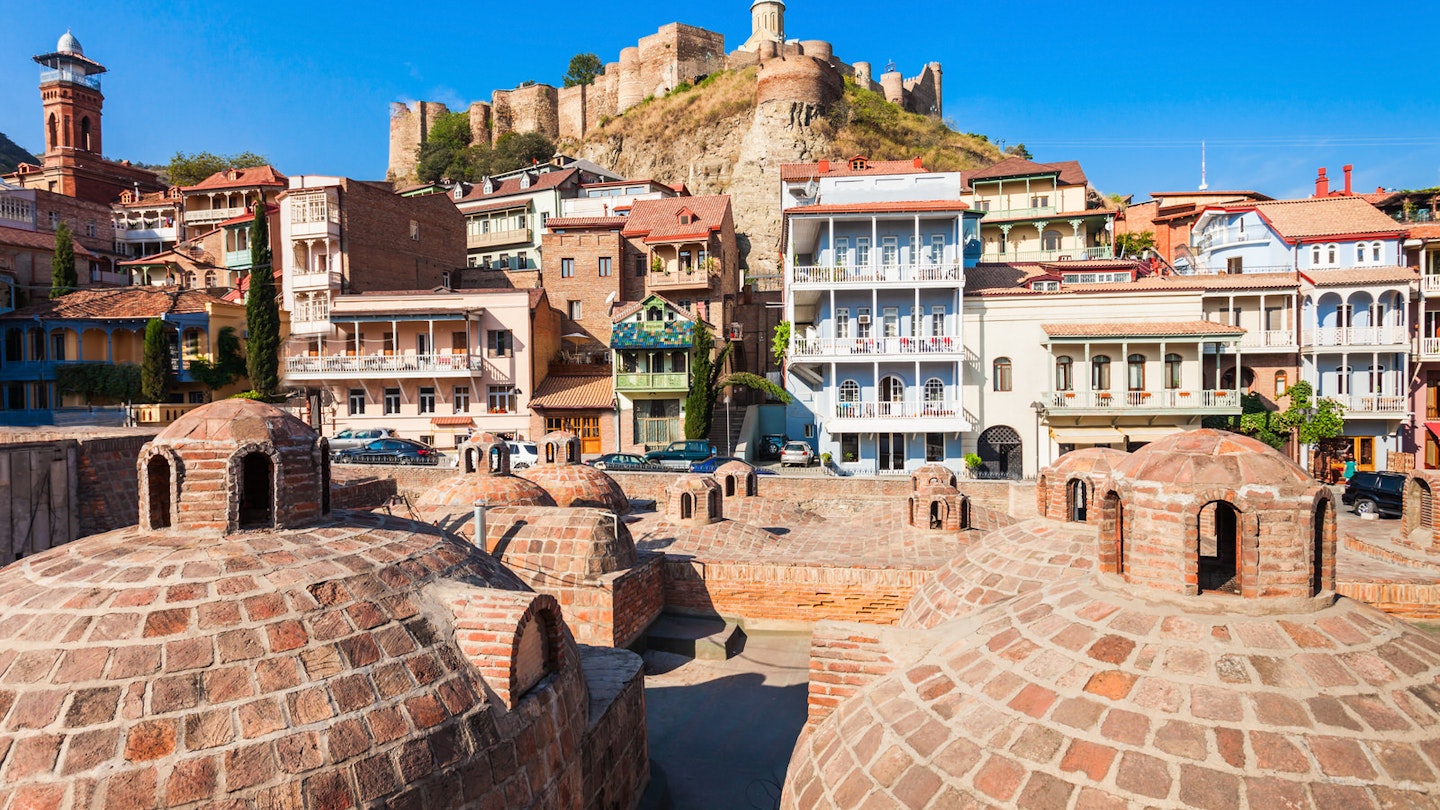Six Reasons to Visit Georgia
Straddling Europe and Asia, and cradled between the greater and lesser Caucasus ranges, Georgia’s rich culture and diverse landscapes belie its modest size. Sub-tropical valleys and imposing mountains immediately inspire awe, while the near legendary hospitality of the Georgian people invites visitors to share in a deeper understanding of the country and its heritage. There are many reasons to visit this surprising and welcoming country; here are just six of them.
Tbilisi’s Capital Charisma
Georgia’s capital, Tbilisi, is charmingly chaotic. Its grand, wide boulevards whittle down to a criss-cross of cobbled streets away from the main thoroughfares, and old, meandering alleyways beckon for attention amidst angular glass-and-steel modern architecture.
Wander through the streets of its hillside Old Town for the best insight into Tbilisi’s past. Many of the buildings have been meticulously restored, their intricately carved wooden verandahs overhanging the colourful houses beneath, while the city’s famous sulphur baths, or abanotubani, continue to invigorate visitors today, centuries after the restorative hot springs were discovered.
Behind the Old Town, Narikala Fortress has crowned the settlement since the 4th century. These days it’s accessible by cable car and offers sweeping views across Tbilisi, including the undulating mesh-metalwork Bridge of Peace, commemorating the end of the war with Russia. Just to the west of the fortress, the dramatic, Soviet-era Kartlis Deda (Mother Georgia) monument surveys the city with both benevolence and strength; a bowl of wine to welcome friends in one hand and a sword to fight enemies in the other.
Incredible Ancient Monasteries and Cathedrals
It’s almost impossible to visit Georgia and escape the deep reverence for its ancient monasteries and cathedrals. Although the churches may seem similar, each is uniquely beautiful and historically significant in its own right. The Gelati Monastery in Kutaisi, for example, was built during the country’s Golden Age in the 12th century and was a thriving center of academia during this time.
By contrast, Bagrati Cathedral has been restored in a far more arresting fashion. Also in Kutaisi, its dome was badly damaged during a 17th-century Ottoman invasion, but it wasn’t until 2010 that renovations began, when an ambitious architect rebuilt sections that had been completely destroyed using modern materials.
Not all of the most beautiful holy sites are cathedral-sized; the modest Motsameta Monastery is less imposing, but the sacred relics of two canonised brothers kept here still inspire the congregation to worship today.
Ancient History at Uplistsikhe
On a windy hill close to Gori in eastern Georgia lie the fascinating remains of one of the most important pagan settlements in the country. Dating to the 7th century BCE, the warren of caves that formed the city of Uplistsikhe once numbered 700, but only around 250 remain. Though paganism died out when Christianity was adopted in the 4th century, Uplistsikhe was inhabited until the 1300s, continuing its strategic position on the Silk Road trading route.
Visitors can wander the dusty, rocky streets to see traces of daily life, including a theatre for entertainment and rituals, pagan temples for worshipping, and even a wine-pressing station, providing a glimpse into a society long past.
The Wonders of Georgian Wine
Winemaking is a part of Georgia’s national psyche, with evidence of the craft dating back 8000 years. Georgians are deeply proud to still be using traditional methods to create their vintages: the grapes are pressed, and the whole lot, including seeds, skin, and stems, is transferred to large clay pots called qvevri, which are buried underground for several months to ferment. This process produces wines with a natural flavor and a much deeper color.
Winery Khareba in the Kakheti region produces both European-style and qvevri wines using Georgian grape varieties. The sprawling hillside winery, set in stunning landscaped grounds, ages and stores wines in a Soviet-era tunnel carved into the mountain.
For a unique experience, try some chacha, a lively spirit distilled from the pulp remaining from grape fermentation. Just remember to go easy as homemade varieties can be quite potent. Gaumarjos (cheers)!
Comforting Cuisine
Come to Georgia hungry—the food here is unashamedly comforting and meals are hearty social occasions. Spicy stews of lamb, beef, or chicken are featured alongside khinkali (spicy dumplings), fresh salads, smoked cheeses, and vegetable dishes like pkhali (crushed aubergine with walnut and garlic).
While each region showcases its specialities, some ubiquitous dishes feature prominently on menus across the land, such as khachapuri, a flat, bread-like pie stuffed with molten cheese, with several regional variations worth sampling.
For a not-too-sweet after-dinner treat, try churchkhela, made by dipping a string of walnuts into grape paste and hanging it to dry. These colorful confections can be found easily throughout Georgia.
Batumi’s Coastal Charms
Shimmering on the Black Sea coast is Batumi, where a laid-back atmosphere is perfect for a relaxing seaside escape. Batumi Boulevard, a 7-km-long pedestrian stretch, features landscaped gardens, sculptures, fountains, and cafes, making it ideal for a leisurely stroll.
Each day, locals and visitors gather to witness the moving sculpture Man and Woman by Tamara Kvesitadze, affectionately known as Ali & Nino, which represents separation following a Soviet invasion.
Batumi’s architecture contrasts with Tbilisi, showcasing an eclectic mix of restored belle époque buildings, soaring towers, and fun, gaudy designs that reflect a development boom in the city.
Make it Happen
Direct flights are available from London Luton to Kutaisi, and from London Gatwick to Tbilisi. There are also various connections offered by other airlines from multiple European cities, making it convenient to reach this captivating destination.
This article was first published in August 2018 and has been updated accordingly.





